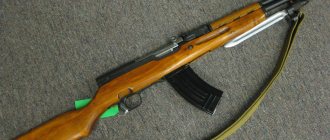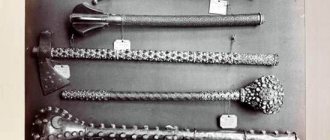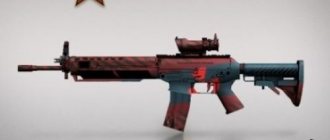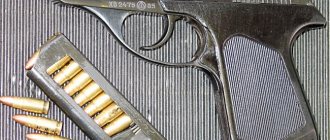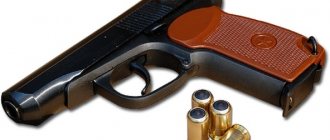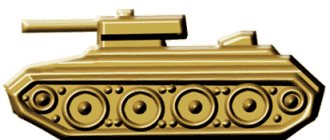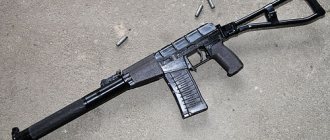| Steyr AUG | |
| Steyr AUG A1 with a barrel of 508 mm (top) and 407 mm (bottom) | |
| Type | machine |
| A country | Austria |
| Service history | |
| Years of use | 1978 - present |
| Adopted | 1978 |
| In service | See Operating Countries |
| Wars and conflicts | East Timor, War in Afghanistan (since 2001), Iraq War, Armed conflict in eastern Ukraine. |
| Production history | |
| Constructor | Horst Wesp Carl Wagner Carl Moser |
| Designed by | 1977 |
| Manufacturer | Steyr-Mannlicher AG & Co KG, ADI Limited, Lithgow Facility, SME Technologies |
| Years of production | 1978 - present |
| Total issued | production continues |
| Options | see Existing modifications |
| Characteristics | |
| Weight, kg | A1/A2 empty: 3.3/3.6 (with 407/508 mm barrel) A3 empty: 3.9 (with 455 mm barrel) A3 SF empty: 3.97 (with 407 mm barrel) 9 mm empty: 3.3 9 mm XS empty: 2.97 Z empty: 3.7/3.75 (with 508/550 mm barrel) empty magazine : 0.13/0.2 (5.56/9 mm), 0.09 (civilian) |
| Length, mm | A1/A2 : 690/790 (with 407/508 mm barrel) A3 : 745 (with 455 mm barrel) A3 SF : 715 (with 407 mm barrel) 9 mm : 665 9 mm XS : 610 Z : 765/805 (with barrel 508/550 mm) |
| Barrel length, mm | A1/A2 : 407, 508 A3 : 365, 407, 455, 508 A3 SF : 365, 407, 508 9 mm : 420 9 mm XS : 325 Z : 407, 508, 550 |
| Height, mm | 275 ( A1/A2 , 9mm) 245 ( A3 ) 232 ( A3 SF ) 210 ( 9mm XS ) 185 ( Z with 9-round magazine) |
| Cartridge | 5.56x45 mm NATO 9x19 mm Parabellum (submachine gun variant) |
| Caliber, mm | 5.56 9 (submachine gun variant) |
| Work principles | removal of powder gases, rotary bolt (automatic) blowback (submachine gun) |
| Rate of fire, rounds/min | 680—750 650-720 (submachine gun version) |
| Initial bullet speed, m/s | 992 (standard) |
| Sighting range, m | 400 (with a 1.5 x sight), up to 600 m (in the machine gun version with more powerful optics). |
| Type of ammunition | detachable box magazine: plastic sector for 10-50 rounds (automatic) steel straight for 25-50 rounds (submachine gun) |
| Aim | A1, A1 9 mm : 1.5X integrated optical sight A2, A2 9 mm, Z : A3, 9 mm Weaver rail XS : Picatinny rail A3 SF : 1.5X integrated optical sight equipped with Picatinny rails |
| Media files on Wikimedia Commons | |
An Austrian soldier with a Steyr AUG rifle practices combat techniques in urban environments during a training exercise.
Steyr AUG
(
A
rmee
U
niversal
G
ewehr - army universal rifle) is a small arms complex released in 1977 by the Austrian company Steyr-Daimler-Puch (now Steyr Mannlicher AG & Co KG). In Australia, the rifle is produced under license under the F88 brand. It has interchangeable barrels of different lengths: the main one is 508 mm, as well as shortened barrels of 350 mm and 407 mm and a heavy barrel of 621 mm.
This rifle uses a bullpup layout, in which the magazine and bolt assembly are located behind the fire control handle and trigger. There are two fire modes: single shot fire and automatic fire. It is also possible to upgrade it to fire single shots and with a cut-off of 3 shots.
Content
- 1. History
- 2 Technical description 2.1 Powder gas automation mechanism
- 2.2 Trigger mechanism
- 2.3 Power
- 2.4 Sights
- 2.5 Design features 2.5.1 Housing and layout
- 2.5.2 Modular structure
- 5.1 Advantages
History[ | ]
The Steyr AUG appeared as part of a program to develop new infantry weapons for the Austrian army. At the end of the 1960s, it was decided that it was necessary to rearm the army with StG.58 rifles (licensed copies of the Belgian FN FAL). A rearmament program was developed, and its direct implementation was entrusted to Steyr Daimler Puch AG and Swarovski Optic. Steyr Daimler Puch AG had to develop and introduce a fundamentally new infantry weapon that would meet the stringent competitive requirements of the Austrian army.
The developers were tasked with creating the most universal single infantry weapon that could perform all the functions previously performed by various weapons of an infantry platoon. In addition, the new infantry weapon system had to be relatively light, transportable, ergonomic, reliable, easy to maintain and have good fire accuracy.
The Steyr company approached the issue in a rather original way: instead of creating something average, it was decided to move along the path of modular assembly. The AUG design consists of blocks of interchangeable modules; thus, having a set of spare parts, it can be easily converted into any weapon from a submachine gun to a sniper rifle. Three Austrian designers played a significant role in the creation of the new weapon: Horst Wesp, Karl Wagner and Karl Moser; on the part of the Austrian army, the project was supervised by Walter Stoll. The developed design cannot claim absolute originality. And before the development of the AUG, bullpup rifles were created; interchangeable barrels and bolt groups had been used in machine guns since the beginning of the 20th century, but it was the Steyr designers who managed to create the most successful combination of developments that existed at that time, which ensured the success of the project and worldwide popularity of this weapon. The first working prototypes of the rifle appeared in the mid-1970s, and in 1977 the new weapon was put into service under the designation StG.77 (German: S
turm
Gewehr
77). In 1978, mass serial production of the Steyr AUG began, which continues to this day[1].
In the 1980s, a decision was made to expand the functionality of the army universal rifle; a set of modules was developed that, by replacing the barrel and bolt group (installing a free bolt), transforms it into a submachine gun using 9x19 mm Parabellum cartridges, for To ensure compatibility with magazines for this cartridge, a special adapter is installed[1][2].
Instead of the front handle, it is possible to install an HK AG36 under-barrel grenade launcher
Subsequently, the improvement of this type of weapon continued to move along the path of increasing versatility. In 2005, the AUG A3 model was introduced, the fundamental difference from earlier models was the abandonment of the integrated optical sight in favor of a standard Picatinny rail and the replacement of the folding front handle with another Picatinny rail. After this modification, it became possible to install almost any standard sight, from collimator to night sight. Replacing the front folding handle allowed the installation of the vast majority of standard modules, from a tactical flashlight and folding handle to an under-barrel grenade launcher or even a combat shotgun; two small additional strips on the side of the barrel allow the installation of a laser target or other necessary additions. Thus, the owner can personally determine the level of functionality he needs and the load on the weapon with additional accessories[1].
CZ75-Auto - when one nerf is not enough
CZ is a pistol unique to CS:GO. He was considered an idiot twice: first in 2014, and then he was attacked in 2018. First things first.
The pistol did not appear in the game immediately. It was added only in 2014 with the Weapons Case 3. If previously snipers mainly bought the P250, now there was no point in it - the CZ was superior to it in all respects. It was the first automatic pistol in the game, a kind of mini-SMG that could save you in emergency situations.
Now it seems that the CZ75 is rather clumsy, and only gains strength in capable hands. This was originally not the case: it had a short animation when switching, higher damage and accuracy, and the kill reward from it was the traditional $300 rather than $100. The pistol irritated pro players so much that many (like Adam friberg Friberg) insisted that it should be removed from the game altogether. As a result, a few months after the addition, CZ75 received a nerf - almost all its parameters were “cut”, and the indignation subsided.
The second time the CZ75 was attacked was after the IEM Season XII - World Championship, where the same Fnatic, which this time was nicknamed Fnaticz, performed miracles with a pistol. What was wrong? After a series of nerfs and small buffs, the CZ75 was back on top: its main advantage (automatic shooting mode) had not gone away, and it was also more accurate than its counterparts when shooting on the run. As a result, the pistol's damage was again reduced and it was no longer possible to kill an enemy with a helmet with one hit. After this, even Gabriel FalleN Toledo and Dennis dennis Edman, who insisted that CZ should be removed from the game, were satisfied.
Look
This is why they didn’t like the CZ75
Technical description[ | ]
An automatic weapon (or rather, a family of small arms) Steyr AUG is an automatic weapon operating on the principle of removing powder gases, with magazine feed, air cooling of a replaceable barrel, arranged according to the bullpup scheme (in which the breech of the barrel, the bolt group and the magazine are located behind the handle fire control and trigger). Consists as standard of six easily replaceable blocks[3][4].
Powder gas automation mechanism[ | ]
The AUG automation is based on a gas venting mechanism with a short working stroke of the gas venting piston. The barrel is locked by turning[1]the bolt with 7 locking lugs behind a steel coupling located in the receiver. The bolt has a cartridge ejector and a spring-loaded reflector. The standard bolt has an ejector located on the right, which ensures that cartridges are ejected to the right. If necessary, the standard bolt can be replaced with one with an extractor on the left, which will ensure the appropriate direction of flight of the cartridges. The bolt is located on the bolt frame, which is mounted inside the weapon body on two hollow tubes. In the standard, the left rod serves as a pusher, transmitting to the bolt the movement of the handle to cock the weapon. The right one is the gas piston rod. Inside these tubes, behind the shutter, there is a return spring, inside which there is a rod - a guide. The charging handle is motionless when firing, but if necessary, it can be rigidly connected to the bolt group by pressing a button located on the handle itself. In the Steyr AUG A2 model, the charging handle can be folded upward and has a slightly modified shape[1].
Trigger mechanism[ | ]
Main article: Trigger mechanism
The trigger mechanism (trigger) is made in the form of a separate module located in the butt. It is connected to the trigger by trigger rods. The safety is made in the form of a transverse button above the handle of the weapon and blocks the trigger pull. The fire modes are switched by pressing the trigger of varying degrees of severity. Partial pressing causes a single shot, full pressing causes a burst. There is no manual fire translator as such. Almost the entire trigger is made of plastic, with the exception of pins, springs, firing pin, and trigger rods. To modify the Steyr AUG into a light machine gun, conversion kits are produced that modify the trigger for firing from an open bolt. There are 3 variants of this module, providing different firing modes: single, bursts with a cut-off of 3 shots, continuous bursts[1][3].
Food[ | ]
Steyr AUG ammunition is fed from double-row box magazines made of impact-resistant plastic, with side inserts made of transparent polymer, for visual control of the amount of ammunition in the magazine. Three types of magazines are produced - with a capacity of 9, 30 and 42 rounds. The first type of stores are usually equipped with models produced for the civilian population[5]. The second type of AUG magazine is equipped as standard, the third type is equipped with a light machine gun; the increased length of the magazine by 42 rounds presents a certain inconvenience when shooting from a prone position. The magazine release is located behind the magazine slot and is equally accessible for right and left hands, although it is located somewhat inconveniently[1][3]. Submachine gun variants use 25-round steel magazines.
Sights[ | ]
The main sighting device for the Steyr AUG A1 is a non-removable 1.5X optical sight built into the carrying handle. The sight body is part of the receiver. But on some samples intended for use as sniper rifles, a Weaver rail was installed instead of a sight and handle. In case of failure of the standard optics, the front and rear sights are located on the upper surface of the body. Starting with the A2 model, the sight is removable and allows the installation of various sight rails, such as a Weaver rail or Picatinny rail. The A3 model has an already installed Picatinny rail for mounting sighting devices and three rails for installing additional devices[1][3][6].
Design features[ | ]
Steyr AUG, like any technical product, has a number of specific design features that distinguish it from similar devices.
Housing and layout[ | ]
The body is made of impact-resistant plastic monolithically, with a bracket covering the trigger and the shooter's hand, and in models A1 and A2 - with a pistol grip. Windows for extracting cartridges are located on the left and right; depending on the type of bolt group, one of them is covered with a plastic cover. Access to the components and mechanisms of the weapon is carried out by removing the butt plate, which is fixed by means of a transverse pin on which the rear sling swivel is located. The hull can be painted in a variety of colors, with the most common being olive green for the military, while there are also desert color options and black for the police forces. The shape of the hull gives the Steyr AUG a characteristic futuristic look[1].
All Steyr AUGs are equipped with a carrying strap and can be equipped with a 40-mm M203 grenade launcher.
Modular structure[ | ]
Steyr AUG in its basic configuration consists of 6 main blocks:
- The barrel block is quick-detachable, fastened by turning onto 8 stops located outside on the breech of the barrel in 2 rows. On the right side of the barrel there is a gas block in which the gas piston and return spring are located. On the left is a spring-loaded latch that secures the barrel in the receiver. Below the block there is a hinge for attaching a folding handle; in the A3 model there is a Picatinny rail. A three-slit flash suppressor is located on the muzzle of the barrel. Barrels are available in 4 types with lengths of 350 mm, 407 mm, 508 mm, 621 mm. The longest barrel is equipped with a folding bipod and is used when modified into a sniper rifle or light machine gun. The bore has a right-hand rifling with a pitch of 1:228 mm (1:9 inches), together with the chamber it is chrome-plated. The combat survivability of the barrel is 15,000 rounds[1][7].
- The receiver (the main element of the weapon) is made of durable aluminum alloy, reinforced with steel plates in areas of greatest load[1].
- The bolt frame and bolt have 2 guides, one of them transmits force from the gas piston, the second - from the weapon’s cocking handle.
- The stock is made of glass fiber reinforced polyamide and is the basis of the entire structure. The external contours of the stock provide the distinctive AUG exterior design. The plastic case contains return springs, a fuse, a receiver latch, and a trigger guard with rods[3].
- The magazine is double-row, with a capacity of 9, 30 or 42 rounds, made of plastic.
Partial assembly and disassembly for maintenance purposes is carried out without the help of special tools. The rifle can be disassembled into 6 main modules[1][3].
Procedure for partial disassembly:
- Separate the store.
- Cock the impact mechanism, leaving the reloading handle in the rearmost position and fixing it in a special recess in the receiver.
- Separate the barrel: press down the barrel lock button with your finger, turn the barrel 45 degrees clockwise using the handle and remove it.
- Sliding the stopper, remove the receiver and bolt frame.
- Remove the trigger mechanism: press the notch in the butt plate and pull out the pin, separate the butt plate and remove the trigger.
Assembly is carried out in reverse order. As we can see from the instructions, in terms of ease of partial disassembly, the AUG is not inferior to the Kalashnikov assault rifle[3].
Existing modifications[ | ]
AUG A1 basic version with 508 mm barrel AUG A2 with short 407 mm barrel Steyr AUG A3 with mounted optical sight, tactical flashlight and front handle.
A free Picatinny rail is visible on the side of the barrel. Steyr AUG in the version of the submachine gun chambered for 9×19 mm Parabellum Currently, there are the following main modifications:
- Steyr AUG A1
- the basic modification, released in 1977, has all the main features characteristic of models of later series. Characteristic features are a non-removable fixed vertical front handle and a built-in low-power optical sight located in the carrying handle. - Steyr AUG A2
differs from the basic model in the presence of a universal mount for NATO standard sights (Weaver rail) and a folding front handle. - The Steyr AUG A3
differs from the base model in the presence of four Picatinny rails: the top one is used for attaching sights, an under-barrel grenade launcher or a vertical front handle can be attached to the bottom, and a laser designator or other necessary additional equipment can be attached to the side ones. - Steyr AUG Z
is a civilian self-loading version of the AUG A2[5]. - Steyr AUG HBAR-T
is a 5.56 mm Marksman rifle, differing from the base model in a longer and heavier barrel. - Steyr AUG LMG
is a 5.56 mm light machine gun based on the HBAR-T.
Any of the Steyr AUG models can be modified using a standard set of modules into a submachine gun, carbine, machine gun, sniper rifle, light machine gun.
The assault rifle comes standard with a 508 mm barrel.[1][7]
As a result of replacing the barrel (with a short barrel of 350 mm or 407 mm) and the bolt group (for a pistol cartridge), a submachine gun chambered for the 9x19 mm Parabellum cartridge is obtained. Standard magazines from Steyr MPi 69 are connected using a special adapter included in the kit[1][7].
In the case of a carbine, a shortened barrel with a length of 407 mm is installed, the rest remains unchanged. This modification is carried out when equipping AUG with vehicle crews and, in some cases, paratroopers.
The sniper rifle comes with an extended barrel of 621 mm and can be equipped with a bipod. When installing a thicker and longer barrel, the accuracy of fire increases, which allows the AUG to be used as a rather mediocre automatic sniper rifle chambered for 5.56x45 mm NATO.[1][7]
When used in a light machine gun configuration, the barrel is replaced with an elongated 621 mm and the bolt group is replaced. Ammunition is fed from high-capacity 42-round magazines or from standard 30-round magazines. The resulting light machine gun is inferior in tactical and technical characteristics to many weapons that originally had this design, but, nevertheless, is capable of effectively performing all the tasks assigned to it [1] [7].
Steyr AUG in various modifications is produced in a number of countries under license. For example, in Australia the AUG variant is produced, which is designated F88A1[1].
AUG and Krieg - when CS:GO almost turned into Call of Duty
In the fall of 2020, on the same day that the CZ75 was nerfed, Valve reduced the price of two rifles with red dot sights - the AUG and SG 553 (Krieg). At first, no one paid attention to this: almost no one used weapons, everyone preferred the classic AK/M4.
But even if a person is a slave of habit, everyone still wants to win, so from month to month AUG and Krieg began to appear in matches more and more often. At first, eSports players didn’t want to learn new spray patterns, but then they got used to it, and CS:GO changed a lot. The difference in skill began to level out, because now it has become easier to shoot more accurately (all because of the sights). The phrase “No hands - take AUG” has even become common among people.
It should be noted that at first the popularity of the AUG grew: the SG 553 was taken less often, because its spray pattern was radically different from the AK-47, but the AUG and M4 were basically similar. And only when Valve again raised the price of the special forces rifle, everyone began to buy (or pick up) the SG 553 in droves. Soon this rifle became a real headache for everyone, since its characteristics were significantly superior to all other analogues.
Esports players cried, but continued to buy SG 553 - otherwise there was simply no way to win. Surprisingly, both rifles remained unchanged since the game's release - they were remembered only after the cost was reduced.
In April 2020, SG 553 received a long-awaited nerf, and the professionals breathed a sigh of relief - especially Nikola NiKo Kovacs.
Look
Operating countries[ | ]
Austrian soldiers with the Steyr AUG during an exercise
The Steyr AUG was developed as part of the Austrian Army's rearmament program according to a new tactical concept common in the 1970s and 1980s.
AUG is a universal rifle complex that allows you to equip infantry platoon soldiers with all the necessary types of light small arms, depending on the mission, and with minimal equipment[1].
In its basic configuration, it is designed for firing at a range of up to 400 meters by small tactical groups of up to a platoon in conditions of fast-moving combat at medium and short distances. The AUG is most effective in urban combat.
The existing advantages of the Steyr AUG can be realized to the maximum extent by arming it with well-trained groups of airmobile infantry, police units, motorized infantry, as part of large military formations with a deeply echeloned and duplicated logistics supply system. The AUG performed quite well during the Iraq War, where it was used in exactly this way.
- Austria - in service with the army and special forces of the Austrian police
- Australia - adopted by the army in 1989, replacing the M16 rifle. It is in service under the designation F88 Austeyr
. The variants used are F88C, F88S-A1, F88SA-1C, F88S-A2 Austeyr. - Argentina - in 1975, it was decided to replace the FN FALs in service with machine guns chambered for 5.56x45 mm; in 1979-1983. The FARA 83 assault rifle was developed (produced in quantities of several hundred units), but in the mid-1980s a decision was made to purchase the first Steyr AUG. However, the issue of choosing a new assault rifle for rearmament remained unresolved until the end of the 1980s (in 1989 - 1990, several more FARA 83s were manufactured with the ability to use Steyr AUG magazines) [8].
- Bulgaria - SOBT are used [ source not specified 380 days
]. - Bolivia[7]
- Brazil - Used by the Brazilian Intelligence Agency since November 2011.
- Great Britain - in special forces units (SAS)[7] and in service with troops in the Falkland Islands Defense Force
- Gambia
- Germany - in German special forces units (GSG-9)[7]
- Djibouti
- Indonesia
- Ireland[7] - Entered service in 1987 as a replacement for the FN FAL[9]. The Steyr AUG A2 and A3 variants are used.
- Italy - in special troops.
- Cameroon - adopted in 1984[9]
- Luxembourg - in service with the army, using the Steyr AUG A2.
- Malaysia - purchased 100 thousand units in 1989. and a production license, the rifles were put into service[9]
- Morocco[7]
- Netherlands
- New Zealand - adopted in 1986[9]. The first 5,000 rifles were produced at the Steyr Daimler Puch plant, all others were produced by Thales Australia (formerly ADI). The New Zealand variant is similar to the Australian F88 Austeyr, but does not have an automatic safety button.
- Oman - adopted by the Royal Guard of Oman in 1981, later adopted by the country's armed forces[9]
- Pakistan
- Papua New Guinea - Variant F88.
- Poland - used by special forces.
- Russia is mainly in service with the Airborne Forces and the FSB, as well as the FSIN and the Russian Guard. This machine gun was first used by Russian troops during the conflict in South Ossetia in 2008.
- Saudi Arabia - adopted in 1980[9]
- USA - in 1994, the import of the automatic version of the Steyr AUG as a civilian weapon was prohibited[10], but assault rifles of this type are used by troops and are in service with police special forces SWAT, border guards and the US Coast Guard[7]
- Republic of China
- Tunisia - adopted in 1978[9]
- Uruguay - ordered[ when?
] 7000 Steyr AUG A2UR for infantry. - Ukraine - small-scale production, incl. options for ammunition 6*45, 6.8*43 and 6.5*39, is in service with the ground units of the Ukrainian Armed Forces [ source not specified 1613 days
]. - Philippines
- Croatia - in special forces.
- Ecuador[7]
AWP - when it was necessary to nerf kennyS
The AWP has always been a cult rifle in Counter-Strike, and in the early years of Global Offensive it seemed like a complete imbecile. The thing is that in aiming mode you could move quite quickly with it. Because of this, snipers began to act more aggressively than in previous versions of the shooter.
Players were not afraid to push with AWP, they took angles that were unintelligible by modern standards, and the most skilled eSports players even turned rounds upside down with it. It was precisely because of the features of the early AWP that Ladislav GuardiaN Kovacs and Jesper Weksel, and especially Kenny kennyS Shrub, shot at their time.
It was not without reason that the Frenchman was considered the strongest sniper in CS:GO. Just look at this highlight:
Look
As a result, Valve decided that something needed to be done about this and reduced the speed of movement in zoom. The game no longer encouraged aggressive attacks. Many commentators believed that the developers primarily wanted to nerf not the rifle, but kennyS himself:
Kenny kennyS Shrub:
“It really hit my motivation. I thought: “Why did they do this?!” It's not fair to me. I really felt like they did it because of me [laughs]. I’m not saying that it really happened, but that’s what I thought.”
In short, after the nerf AWP became even less dynamic than it was in 1.6. In addition, the so-called anscopes (shots without a sight) have lost their effectiveness. More passive snipers were not affected as much by the nerf, but aggressive ones had to significantly change their playstyle. Previously, the AWP dictated the course of the game, now it has become just one of the rifles.
Advantages and disadvantages[ | ]
Like any other weapon, the Steyr AUG has its advantages and disadvantages, some of them are due to the bullpup design, some are an individual feature of this model[7].
Advantages[ | ]
- The bullpup construction scheme allows you to reduce the overall length of the weapon while maintaining the same barrel length.
- The displacement of the bolt group to the butt has a positive effect on shooting accuracy.
- The center of gravity shifted to the butt allows the fighter to quickly transfer fire to the front and in depth thanks to the low magnification optical sight.
- Quite high reliability of components and mechanisms, the ability to fire when there is water in the barrel [7].
- The ability to rearrange weapon modules according to the assigned tactical task, from a submachine gun to a light machine gun or a sniper rifle.
- Possibility of adaptation for both right-handed and left-handed people by moving the extractor window.
- Starting with the A2 model, the presence of a universal mount for NATO standard sights allows you to equip the weapon with sights according to the assigned tactical task. In the A3 model, the equipment with universal mounts has only increased, which allowed the Steyr AUG complex to gain even greater flexibility in settings for the intended tasks.
- The presence of a magazine made of translucent plastic allows you to visually control the amount of ammunition[7].
Disadvantages[ | ]
- Highly located sighting devices force the shooter to rise higher from cover, for example, when shooting from a prone position[7].
- In combat conditions, it is difficult for a left-handed person to use a machine gun configured for a right-handed person, since the extractor window is located too close to the shooter’s face. When firing from the left hand with a right-handed extractor, the cartridges fly straight into the shooter's face. The Steyr AUG has the ability to change the location of the cartridge ejector window, but in combat conditions it is almost impossible to replace it[7].
- The specific location of the magazine makes reloading much more difficult, especially when shooting from a prone position.
- The location and specific design of the return spring system can lead to weapon failures when attempting to fire after removing the machine gun from liquid mud. In this case, it will be necessary to manually chamber the next cartridge, which is, however, better than completely disabling other types of weapons with the magazine located after the trigger guard (true for machine guns in the absence of a gas piston)[7][ not in the source
].
The short-lived happiness of the actress
In her personal life, Julia could not achieve happiness. She was married to a man named Stepan. They became the parents of a daughter, Polina. But the husband betrayed their marriage and went to the artist’s best friend. From then on, Yulia learned to live independently, to be responsible for herself and her child.
More than once she had to face male infidelity, the meanness of loved ones and betrayal. Then the actress realized that it was better not to dream of a happy married life at all.
One day she met Andrei Skulov, he became a support for the artist. Only Aug’s happiness was destroyed; in 2015, Julia’s chosen one died. They were together for 15 years. Andrei suffered a heart attack and died in his sleep.
It was not easy for Yulia; after the death of her husband, she was left with a large loan. She managed to get out of debt only at the beginning of 2020.
Polina studied at the acting course at GITIS. The actress's daughter followed in her footsteps. Together they starred in the film “Heavenly Wives of the Meadow Mari” when Polina was only 15 years old.
Notes[ | ]
- ↑ 12345678910111213141516171819
Description of Steyr AUG on weapon.at.ua - description of Steyr AUG on the website tools-of-death.ru
- ↑ 1 2 3 4 5 6 7 8
description of Steyr AUG Archived February 7, 2009. on the website sniper.ru - description of Steyr AUG Archived copy dated August 21, 2009 on the Wayback Machine on the website legendary-arms.ru
- ↑ 12
Description of AUG Z Archived copy dated April 16, 2009 on the Wayback Machine (English) on the manufacturer’s website - description of Steyr AUG Archived May 10, 2008. on the website liveguns.ru
- ↑ 12345678910111213141516171819
Sergey Monetchikov. “Star Blaster”, or the Austrian assault rifle StG.77 (AUG) Archival copy dated February 7, 2009 on the Wayback Machine // “Brother” magazine, February 2007 - Ronaldo Olive. Argentina's Indigenous Rifle Attempts // Small Arms Defense Journal, May 2015
- ↑ 1234567
Steyr AUG assault rifle // Master Gun magazine, No. 69, December 2002. pp. 54-58 - Corey Sattler. Pre-Ban or Post-Ban: More than just a date // “Small Arms Review”, August 1999
- Article “Heroes of our time: The best rifles of the 20th century” on the website of the magazine “Popular Mechanics”

